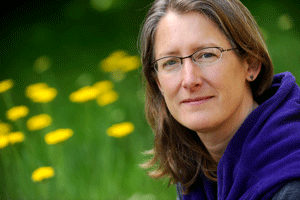Great Sunflower Project expands scope to determine best plants for supporting pollinators
The Great Sunflower Project is moving beyond the backyard this summer.

Professor of Biology Gretchen LeBuhn.
The popular project is encouraging its corps of more than 100,000 volunteers to observe bees and any other pollinators they see, on all kinds of plants and in all kinds of places. Participants can now report their bee counts from a walk on a nature trail, a thorough search of a local park or even a casual encounter with a bumblebee flying by.
“We’ve opened up the project to new ways of sampling pollination,” said San Francisco State Professor of Biology Gretchen LeBuhn, who started the project six years ago. She said the new sampling methods were driven in part by the data already collected, and in part by requests from the citizen scientists.
The project’s data are beginning to reveal how pollination happens in gardens, and people can check to see how well backyards in their state stack up against others, when it comes to bee visits per hour. “But one of the things we realized as we've been analyzing our data is that we can't speak to what's happening in natural areas,” LeBuhn said. The new sampling can help fill in the blanks, she explained, in wild environments such as desert, chaparral and coastal habitats.
“If people can tell us where they were when they observed the bees, we can convert that into latitude and longitude information and start to build up some information about which natural habitats are doing well and poorly” in terms of pollination, LeBuhn said.
The new sampling also moves beyond sunflower observations to help the scientists determine how well certain plants do at supporting pollinators. LeBuhn says there is a lot of anecdotal evidence about this, but surprisingly little research.
“A lot of people came to us and said, ‘now I know that I have three bees per hour in my garden, so what should I do next?’” LeBuhn said. To answer this question, her team began a habitat assessment project this year to discover what kinds of plants and other garden features—from water to mulching—could improve the habitat for pollinators. “Once we started doing this,” she explained, “we realized how little data we have on what the key plants are.”
LeBuhn hopes to have a set of habitat assessment tools online next year, but she suggests that people collect data on their backyard pollinators and plants now, so that they can be ready to make changes that bring in more bees.
The Great Sunflower Project will hold its annual Great Bee Count on August 17 to encourage users to upload their observations. The project’s data has been requested by federal agencies, classrooms, and the Weather Underground forecast website. "My biggest dream is to have the data used as many times and in as many ways as possible," LeBuhn said.
###
Through the participation of over 100,000 citizen scientists the Great Sunflower Project aims to collect information about the whereabouts and activities of pollinating bees, and to provide those bees with more pollen resources. To join The Great Sunflower Project, visit the website at http://www.greatsunflower.org or follow the project on Twitter or Facebook.
SF State is the only master's-level public university serving the counties of San Francisco, San Mateo and Marin. The University enrolls nearly 30,000 students each year and graduates about 8,000 annually. With nationally acclaimed programs in a range of fields -- from creative writing, cinema and biology to history, broadcast and electronic communication arts, theatre arts and ethnic studies -- the University's more than 219,000 graduates have contributed to the economic, cultural and civic fabric of San Francisco and beyond.